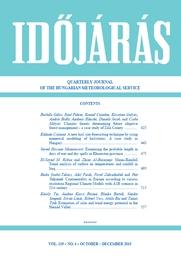IDŐJÁRÁS - angol nyelvű folyóirat
Climatic threats determining future adaptive forest management – a case study of Zala County
Borbála Gálos, Ernő Führer, Kornél Czimber, Krisztina Gulyás, András Bidló, Andreas Hänsler, Daniela Jacob, and Csaba Mátyás
idojaras.2015.4.1 (p. 425–)
Borbála Gálos, Ernő Führer, Kornél Czimber, Krisztina Gulyás, András Bidló, Andreas Hänsler, Daniela Jacob, and Csaba Mátyás
idojaras.2015.4.1 (p. 425–)
A new hail size forecasting technique by using numerical modeling of hailstorms: A case study in Hungary
Kálmán Csirmaz
idojaras.2015.4.2 (p. 443–)
Kálmán Csirmaz
idojaras.2015.4.2 (p. 443–)
Examining the probable length in days of wet and dry spells in Khuzestan province
Seyed Hossein Mirmousavi
idojaras.2015.4.3 (p. 475–)
Seyed Hossein Mirmousavi
idojaras.2015.4.3 (p. 475–)
Mann–Kendall trend analysis of surface air temperatures and rainfall in Iraq
El-Sayed M. Robaa and Zhian Al-Barazanji
idojaras.2015.4.4 (p. 493–)
El-Sayed M. Robaa and Zhian Al-Barazanji
idojaras.2015.4.4 (p. 493–)
Continentality in Europe according to various resolution regional climate models with A1B scenario in the 21st century
Beáta Szabó-Takács, Aleš Farda, Pavel Zahradníček, and Petr Štěpánek
idojaras.2015.4.5 (p. 515–)
Beáta Szabó-Takács, Aleš Farda, Pavel Zahradníček, and Petr Štěpánek
idojaras.2015.4.5 (p. 515–)
Estimation of solar and wind energy potential in the Hernád Valley
Károly Tar, Andrea Kircsi Bíróné, Blanka Bartók, Sándor Szegedi, István Lázár, Róbert Vass, Attila Bai, and Tamás Tóth
idojaras.2015.4.6 (p. 537–)
Károly Tar, Andrea Kircsi Bíróné, Blanka Bartók, Sándor Szegedi, István Lázár, Róbert Vass, Attila Bai, and Tamás Tóth
idojaras.2015.4.6 (p. 537–)
IDŐJÁRÁS folyóirat

Az IDŐJÁRÁS a HungaroMet Nonprofit Zrt. negyedévenként megjelenő angol nyelvű folyóirata
Megrendelhető a journal.idojaras@met.hu címen.
A szerzőknek szánt útmutató itt olvasható.
Megrendelhető a journal.idojaras@met.hu címen.
A szerzőknek szánt útmutató itt olvasható.










